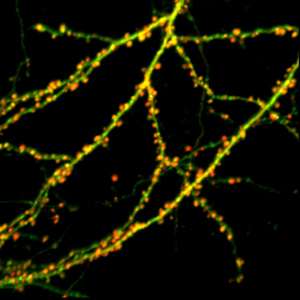Contributions of a 'sorting nexin' protein to learning impairments in Down's syndrome

Every year, roughly 1 in 1,000 children worldwide are born with Down's syndrome. This developmental disorder, associated with potentially severe intellectual and learning disabilities among other characteristics, is caused by the presence of a third copy of chromosome 21, resulting in abnormal activity levels for the more than 300 genes on this chromosome. Scientists have had difficulty identifying the core genes responsible for the disorder, but Wanjin Hong's team at the A*STAR Institute of Molecular and Cell Biology in Singapore have identified a gene with an important role in brain signaling that is one possible culprit1.
Hong and colleagues focused their attention on sorting nexin 27 (SNX27), one of a family of proteins that coordinate movement of other proteins to different compartments of the cell. Previously, the team showed that SNX27 contains distinctive structural features that suggested it may be active at neuronal synapses2. In addition, mice lacking this protein displayed severe developmental and neurological abnormalities, including measurable cognitive defects.
"SNX27-knockout mice demonstrated behavioral characteristics that make them good candidates for research on learning and memory," explains Li Shen Loo, a research scientist in Hong's laboratory. Intriguingly, this study also revealed that lower levels of SNX27 were also apparent in brain tissue from patients with Down's syndrome, and showed that SNX27 production is reduced by one of the genes present on chromosome 212.
Loo and Hong decided to examine brain structure and function in SNX27-deficient mice. They observed considerable fluid accumulation within the mutant mouse brain and underdevelopment of the dentate gyrus—a part of the brain responsible for learning and memory. These alterations made further analysis tricky, according to Loo.
"The knockout brains were too soft and watery to characterize with traditional techniques," she says, "but I was able to investigate the mechanism of memory impairment in these mice using live cell imaging techniques." By examining different combinations of fluorescently-labeled proteins in neurons from wild-type and SNX27-deficient mice, Loo and her colleagues could directly observe the real-time behavior of individual synapses in the presence and absence of SNX27.
Those experiments confirmed that SNX27 is predominantly found within dendritic spines (see image), the part of the neuron that receives incoming signals at the synapse. SNX27 specifically resides within structures called recycling endosomes, which help to shuttle neurotransmitter receptors and other proteins between the cellular interior and the cell surface.
When the researchers experimentally simulated long-term potentiation, the neuronal activation process associated with memory building, they observed that SNX27-bearing endosomes moved from the cell interior to the surface. These endosomes also contained GluA1, a component of the receptor for the neurotransmitter glutamate. In the absence of SNX27, GluA1 is no longer efficiently transported to the surface of the dendritic spines—in fact, it become susceptible to degradation. Since glutamate–GluA1 signaling is critical for long-term potentiation, SNX27 could play a major role in enabling transmission of memory-related signals.
"These results could account for the learning deficits observed in Down's syndrome," notes Loo, who sees a potential therapeutic opportunity. "Since Down's syndrome patients produce less SNX27, re-introducing the protein may restore memory function," she says.
More information: Loo, L. S., Tang, N., Al-Haddawi, M., Dawe, G. S. & Hong, W. "A role for sorting nexin 27 in AMPA receptor trafficking." Nature Communications 5, 3176 (2014). dx.doi.org/10.1038/ncomms4176
Wang, X., Zhao, Y., Zhang, X., Badie, H., Zhou, Y. et al. "Loss of sorting nexin 27 contributes to excitatory synaptic dysfunction by modulating glutamate receptor recycling in Down's syndrome." Nature Medicine 19, 473–480 (2013). dx.doi.org/10.1038/nm.3117



















